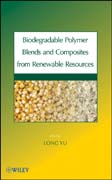
Biodegradable Polymer Blends and Composites from Renewable Resources providesa comprehensive, current overview of biopolymeric blends and composites and their applications in various industries. The book is organized according to the type of blend or composite. For each topic, the relationship between the structure of the blends/composites and their respective properties is explored, with particular focus on interface, compatibility, mechanical, and thermal properties. Real-life applications and potential markets are discussed. This is a premier reference for graduate students and researchers in polymer science, chemical and bio engineering, and materials science. INDICE: PART I: NATURAL POLYMER BLENDS AND COMPOSITES. 1. Polymers from Renewable Resources (L. Yu and L. Chen). 1.1 Introduction. 1.2 Natural Polymers.1.3 Synthetic Polymers from Natural Monomers. 1.4 Polymers from Microbial Fermentation. 1.5 Summary. 2. Starch - Cellulose Blends (I. S. Arvanitoyannis andA. Kassaveti). 2.1 Introduction. 2.2 Starch and Starch Derivatives. 2.3 Cellulose and Cellulose Derivatives. 2.4 Starch-Cellulose Blends. 2.5 Applications.3. Starch Sodium Caseinate Blends (I. S. Arvanitoyannis and P. Tserkezou). 3.1 Introduction. 3.2 Starch and Starch Derivatives. 3.3 Sodium Caseinate Derivatives. 3.4 Starch- Sodium Caseinate Blends. 3.5 Applications. 3.6 Comparison between Sodium Caseinate and other Edible films. 4. Novel Plastics and Foams from Starch and Polyurethanes (Y. Lu and L. Tighzert). 4.1 Introduction. 4.2 Starch-Filled Polyurethane Elastomers and Plastics. 4.3 Starch-Filled Polyurethane Foams. 4.4 Starch Grafted with Polyurethanes. 4.5 Thermoplastic Starch/Polyurethane Blends. 4.6 Concluding Remarks. 5. Chitosan Properties and application(N. Soares). 5.1 Sources. 5.1 Structures. 5.2 Application in Food Industry. 5.3 Antimicrobial Property. 5.4 Others Properties. 5.5 Chitosan derivatives . 6. Blends and Composites Based on Cellulose/Natural Polymers (Y. Wang and L. Zhang). 6.1 Introduction. 6.2 Cellulose: Structure and Solvents. 6.3 Cellulose/Natural Polymers Blends. 6.4 Cellulose Derivatives/Natural Polymers Blends. 6.5Promising Application of Cellulose Blends. PART II: ALIPHATIC POLYESTER BLENDS. 7. Stereocomplex between Enantiomeric Poly(lactide)s (H. Tsuji and Y. Ikada). 7.1 Introduction. 7.2 Stereocomplex formation. 7.3 Methods for inducing stereocomplexation. 7.4 Physical Properties. 7.5 Biodegradation. 7.6 Applications. 8. Polyhydroxyalkanoates Blends and Composities (G. Q. Chen and Tsinghua). 8.1 Introduction. 8.2 PHA Blended with Starch or Cellulose. 8.3 PHA Blended with PLA. 8.4 PHA Blended with PCL. 8.5 Blending of Different PHA. 8.6 PHA Blending with other Polymers. 8.7 PHA Composites. PART III: HYDROPHOBIC AND HYDROPHILIC POLYMERIC BLENDS. 9. Starch-Poly(hydroxyalkanoate) Composites and Blends (R. Shogren). 9.1 Summary of starch, PHA structure and properties. 9.2 Why blend starch with PHA's?. 9.3 Problems with starch-PHA blends. 9.4 Granular starch-PHA composites. 9.5 Gelatinized starch-PHA blends. 9.6 Thermoplastic Starch/PHA Laminates and Foams. 9.7 Biodegradability, Recycling and Sustainability. 9.8 Applications and Production. 9.9 Future Research Needs and Directions. 10. Biodegradable Blends Based on Microbial Poly(3-hydroxybutyrate) and Natural Chitosan (C. Chen and L. Dong). 10.1 Introduction. 10.2 Preparation and Properties. 10.3 Conclusion. PART IV: NATURAL FIBER-REINFORCED COMPOSITES. 11. Starch-Cellulose Fibres Composites (A. Vquez and V. Alvarez). 11.1 Introduction. 11.2 Starch Polymer. 11.3 Starch-Cellulose Fibre Composites. 11.4 Starch Based Blends as Polymer Matrix . 11.5 Starch Based Blend/Natural Fibre Composites . 11.6Conclusion. 12. PLA/Cellulosic Fiber Composites (M. Shibata). 12.1 Introduction. 12.2 PLA/Abaca Composites. 12.3 PLA/Wood Flour Composites. 12.4 PLA/Lyocell Composites. 12.5 Conclusions. 13. Biocomposites of Natural Fibres and Poly(3-hydroxybutyrate) and Copolymers: Improved Mechanical Properties Through Compatibilization at the Interface (S. Wong and R. A. Shanks). 13.1 Traditional Composites and Novel Biodegradable Composites. 13.2 Natural Fibres. 13.3 Mechanical Properties of Natural Fibres. 13.4 Biodegradable Polymers. 13.5 Major Problems Associated with High Strength Composites. 13.6 Summary. 14. Starch-Fiber Composites (M. A. Hanna and Y. Xu). 14.1 Introduction. 14.2 Starch-Based Biopolymers. 14.3 Natural Fibers. 14.4 Starch-Natural Fiber Blends. 14.5 Summary. PART V: BIODEGRADABLE NANOCOMPOSITES. 15. Starch based nanocomposites using layered minerals (H.R. Fischer and J.J. de Vlieger). 15.1 Introduction. 15.2 Starch-montmorillonite nano-composites. 15.3 Starch based nanocomposites using different layered minerals. 15.4 Biodegradable starch-polyester nanocomposite materials. 15.5 Discussion and Conclusions. 16. Polylactide Based Nanocomposites (S. S. Ray and J. Ramontja). 16.1 Introduction. 16.2 PLA Nanocomposites based on Clay. 16.3 PLA Nanocomposites based on Carbon Nanotubes. 16.4 PLA Nanocomposites based on other Nanofillers. 16.5 Properties of PLA Nanocomposites. 16.6 Biodegradability. 16.7 Melt Rheology. 16.8 Foam Processing . 16.9 Applications Possibilities and Future Prospect. 17. Advances in Natural Rubber/Montmorillonite Nanocomposites (D. Jia, L. Liu, X. Wang, B. Guo, and Y. Luo). 17.1 Introduction. 17.2 Materials and Process. 17.3 Characterization. 17.4 Results and Discussions. 17.5 Summary. PART VI: MULTILAYER DESIGNED MATERIALS. 18. MultilayerCoextrusion of Starch/Biopolyester (L. Avous). 18.1 Introduction. 18.2 Materials and Process. 18.3 Characterization. 18.4 Results and Discussions. 18.5 Conclusion.
- ISBN: 978-0-470-14683-5
- Editorial: John Wiley & Sons
- Encuadernacion: Cartoné
- Páginas: 500
- Fecha Publicación: 31/10/2008
- Nº Volúmenes: 1
- Idioma: Inglés
